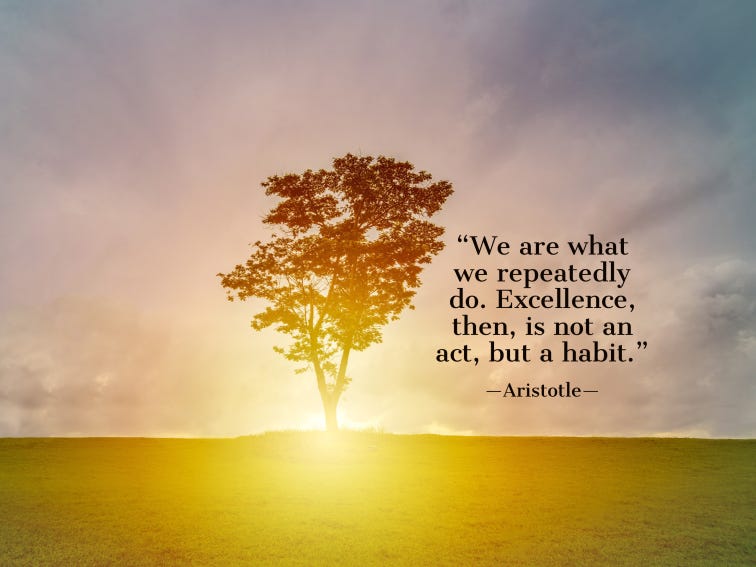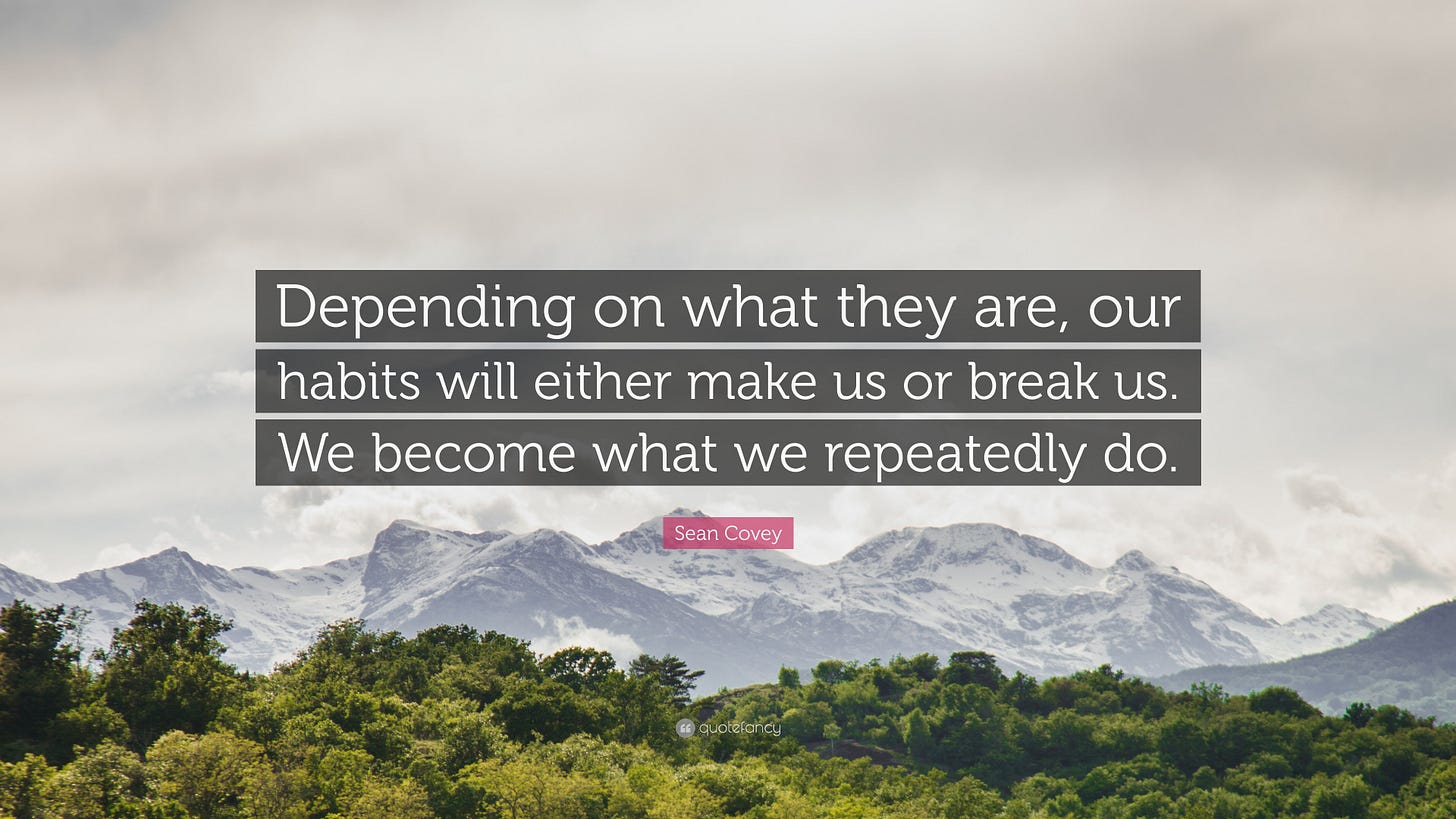8 Steps to Greatness
Proven Techniques for Personal Development and Growth
Welcome to another Evolve with David Newsletter where together, we can evolve beyond our wildest dreams.
Todays newsletter will “be going over “8 Steps to Greatness: Proven Techniques for Personal Development and Growth." My goal is to provide you with practical and effective strategies for achieving your personal and professional goals.
Personal development and growth refer to the process of improving oneself through various methods, such as learning new skills, changing negative habits, and developing a positive mindset. It is a continuous journey of self-improvement, aimed at achieving personal and professional goals and living a fulfilling life.
The purpose of this newsletter is to share with you 8 proven techniques for personal development and growth. These techniques have been selected based on their effectiveness and applicability to a wide range of individuals. We hope that by following these steps, you will be able to enhance your personal and professional life, achieve your goals, and become the best version of yourself.
Step 1: Set Clear Goals
One of the most important steps in personal development and growth is setting clear goals. Goals give you direction, purpose, and motivation. They help you focus your energy and resources on what truly matters to you, and they provide a benchmark for measuring your progress.
Setting clear goals is essential because it helps you:
Define what you want to achieve
Clarify your priorities
Create a roadmap for success
Measure your progress
Stay focused and motivated
Make better decisions
Overcome obstacles and challenges
Celebrate your successes
Tips for setting achievable goals:
Be specific: Clearly define what you want to achieve. The more specific your goal, the easier it will be to measure progress and stay motivated.
Make it measurable: Create a way to measure your progress, such as a timeline or a specific target number.
Be realistic: Make sure your goal is achievable given your current circumstances and resources.
Set a deadline: Give yourself a specific timeline to achieve your goal. This will help you stay focused and motivated.
Write it down: Write down your goal and keep it in a visible place, such as on your phone or a sticky note on your computer. This will help you stay accountable and focused on your goal.
Break it down: Break down your goal into smaller, manageable steps. This will help you stay motivated and make progress towards your goal.
By setting clear and achievable goals, you can take the first step towards personal development and growth. With dedication and perseverance, you can achieve great things and become the best version of yourself.
Step 2: Create a Plan of Action
Once you have set clear goals, the next step is to create a plan of action. A plan of action is a roadmap that outlines the specific steps you need to take to achieve your goals. It helps you break down your goals into smaller, more manageable tasks and provides a framework for measuring your progress.
Creating a plan of action is essential because it helps you:
Identify the specific steps you need to take to achieve your goals
Break down your goals into smaller, more manageable tasks
Prioritize your tasks and focus your energy on what's most important
Track your progress and make adjustments as needed
Stay motivated and avoid distractions
Hold yourself accountable for your actions
Celebrate your successes
Tips for creating a plan that works:
Start with the end in mind: Begin by visualizing the end result and working backward to identify the steps needed to achieve your goal.
Break it down: Divide your goal into smaller, more manageable tasks. This will help you avoid feeling overwhelmed and make steady progress towards your goal.
Set deadlines: Assign specific deadlines to each task to keep yourself on track and motivated.
Prioritize your tasks: Determine which tasks are most important and focus your energy on completing those first.
Be flexible: Be open to adjusting your plan as needed. Circumstances may change, and you may need to modify your plan to stay on track.
Stay motivated: Use tools such as visual aids, reminders, and rewards to stay motivated and focused on your goal.
By creating a plan of action, you can turn your goals into a reality. With a clear roadmap and dedication, you can make steady progress towards achieving your personal and professional goals.
Step 3: Focus on One Thing at a Time
When it comes to personal development and growth, it can be tempting to try to do everything at once. However, attempting to tackle multiple goals simultaneously can lead to feelings of overwhelm and burnout. That's why it's important to focus on one thing at a time.
Focusing on one thing at a time is essential because it helps you:
Avoid feeling overwhelmed
Increase your productivity and efficiency
Stay focused and engaged in the task at hand
Produce higher-quality work
Reduce stress and anxiety
Improve your ability to make decisions
Make progress towards your goals
Tips for staying focused and avoiding distractions:
Prioritize your tasks: Determine which tasks are most important and focus your energy on completing those first.
Eliminate distractions: Remove anything that could distract you from the task at hand, such as social media notifications, email alerts, or unnecessary noise.
Use the Pomodoro technique: Break your work into 25-minute intervals, followed by a 5-minute break. This can help you stay focused and avoid burnout.
Practice mindfulness: Focus on the present moment and the task at hand. Avoid thinking about other tasks or distractions.
Take breaks: Allow yourself time to rest and recharge. This will help you stay focused and avoid burnout.
Use tools to stay focused: Tools such as noise-cancelling headphones, to-do lists, and apps that block distracting websites can help you stay focused and productive.
By focusing on one thing at a time, you can increase your productivity and efficiency, reduce stress and anxiety, and make steady progress towards your personal and professional goals.
Step 4: Develop Positive Habits
Developing positive habits is an essential part of personal development and growth. Habits are the behaviors and routines that we engage in every day, and they have a significant impact on our physical and mental health, happiness, and overall success.
Developing positive habits is important because it helps you:
Create structure and consistency in your life
Improve your physical and mental health
Boost your self-discipline and willpower
Achieve your goals more easily and efficiently
Increase your overall happiness and life satisfaction
Tips for developing positive habits and breaking negative ones:
Start small: Begin by developing one positive habit at a time. Trying to change too much at once can lead to failure and frustration.
Identify your triggers: Figure out what triggers your negative habits, and then take steps to avoid or eliminate those triggers.
Replace negative habits with positive ones: Identify a positive habit that can replace the negative one. For example, if you tend to snack on junk food when you're stressed, replace that habit with a healthier snack, such as fruit or nuts.
Use positive reinforcement: Reward yourself for developing positive habits. This can be something as simple as congratulating yourself or treating yourself to a small indulgence.
Stay consistent: Stick to your new habits consistently for at least 21 days. This will help to cement them as a regular part of your routine.
Get support: Enlist the help of friends, family members, or a support group to help you stay accountable and motivated.
By developing positive habits and breaking negative ones, you can create a healthier, happier, and more successful life for yourself. Remember, it's never too late to start developing positive habits, and small changes can lead to big results over time.
Step 5: Embrace Failure
Embracing failure is a crucial step in personal growth and development. Many people are afraid of failure, seeing it as a sign of weakness or incompetence. However, failure is an inevitable part of life, and learning how to embrace it can lead to greater success and fulfillment in the long run.
Embracing failure is important because it helps you:
Build resilience and perseverance
Develop a growth mindset
Learn from your mistakes and make improvements
Gain a sense of empowerment and confidence
Expand your comfort zone and take more risks
Achieve greater success and fulfillment in the long run
Tips for reframing failure as a learning opportunity:
Shift your mindset: Instead of viewing failure as a negative experience, see it as an opportunity for growth and learning.
Analyze your mistakes: Take time to reflect on what went wrong and why. Use this information to make improvements and avoid making the same mistakes in the future.
Focus on progress, not perfection: Rather than striving for perfection, focus on making progress and learning from your mistakes along the way.
Practice self-compassion: Treat yourself with kindness and understanding when you experience failure. Remember that everyone makes mistakes, and that failure is a natural part of the learning process.
Keep a growth journal: Write down your experiences with failure and what you learned from them. This can help you stay focused on the positive aspects of failure and track your progress over time.
Take action: Use the lessons you've learned from failure to take positive action towards your goals. Don't let fear of failure hold you back from taking risks and pursuing your dreams.
By embracing failure and seeing it as a learning opportunity, you can build resilience, gain confidence, and achieve greater success and fulfillment in your personal and professional life.
Step 6: Cultivate a Growth Mindset
Cultivating a growth mindset is a key step in personal development and growth. The concept of a growth mindset was developed by psychologist Carol Dweck and refers to the belief that one's abilities and intelligence can be developed through hard work, persistence, and learning from mistakes.
A growth mindset is characterized by:
Belief in the potential for growth and improvement
Willingness to take on challenges and learn from mistakes
Focus on effort and hard work rather than innate ability
Openness to feedback and constructive criticism
Resilience and perseverance in the face of obstacles
Tips for developing a growth mindset:
Embrace challenges: Instead of shying away from challenges, embrace them as opportunities to learn and grow.
Learn from mistakes: Rather than seeing mistakes as failures, see them as opportunities to learn and improve.
Focus on effort and progress: Instead of fixating on results or outcomes, focus on putting in effort and making progress towards your goals.
Practice self-reflection: Take time to reflect on your experiences, identify areas for improvement, and set goals for growth and development.
Surround yourself with positive influences: Surround yourself with people who encourage growth and development and who support your efforts to cultivate a growth mindset.
Stay curious: Keep an open mind and stay curious about new ideas and experiences. This can help you stay motivated and engaged in your personal and professional life.
By cultivating a growth mindset, you can unlock your full potential, overcome obstacles, and achieve greater success and fulfillment in your personal and professional life. Remember, developing a growth mindset is an ongoing process that requires patience, persistence, and a willingness to learn and grow.
Step 7: Build a Support Network
Building a support network is an essential step in personal growth and development. No one can achieve success and fulfillment alone, and having a supportive community can help you stay motivated, overcome obstacles, and achieve your goals.
A support network is important because it helps you:
Stay motivated and focused on your goals
Gain perspective and insights from others
Receive encouragement and support during challenging times
Develop new skills and knowledge through collaboration and feedback
Expand your network and build meaningful relationships
Tips for building and maintaining a support network:
Identify your needs: Determine what type of support you need and who can provide it. This could include mentors, friends, family members, colleagues, or members of a professional organization.
Be proactive: Reach out to potential supporters and ask for their help or advice. Don't be afraid to initiate conversations or meetings.
Give back: Offer your support and expertise to others in your network. This can help you build stronger relationships and gain new perspectives.
Attend networking events: Attend industry conferences, workshops, or other events to meet new people and expand your network.
Join a group or organization: Join a professional or personal development group to meet like-minded individuals and gain support and feedback.
Use technology: Utilize social media or online forums to connect with others who share your interests or goals.
Be consistent: Maintain regular communication with your support network and stay engaged in their lives as well. This can help you build deeper relationships and strengthen your support system over time.
By building a strong support network, you can gain valuable insights and support, overcome challenges, and achieve greater success and fulfillment in your personal and professional life. Remember, building a support network is an ongoing process that requires effort, openness, and a willingness to give and receive support.
Step 8: Learn Continuously
Continuous learning is a crucial step in personal growth and development. Learning new skills, acquiring knowledge, and gaining new perspectives can help you expand your horizons, stay relevant, and achieve your goals.
Continuous learning is important because it helps you:
Keep up with changing technologies and trends
Enhance your skills and expertise
Adapt to new challenges and opportunities
Gain new perspectives and insights
Stay curious and engaged in your personal and professional life
Tips for incorporating learning into daily life:
Set aside time for learning: Schedule dedicated time for learning into your daily or weekly routine. This could include reading books, attending webinars, or taking online courses.
Embrace new challenges: Look for opportunities to take on new challenges or projects that will stretch your skills and knowledge.
Seek out mentors: Find mentors or advisors who can provide guidance and support in your areas of interest or expertise.
Attend conferences and workshops: Attend industry conferences, workshops, or other events to stay up-to-date on new trends and technologies.
Engage in online learning: Take advantage of online resources such as webinars, podcasts, and educational websites to supplement your learning.
Join a community of learners: Join a professional or personal development group to connect with others who share your interests and goals.
Stay curious: Maintain an open mind and stay curious about new ideas and experiences. This can help you stay motivated and engaged in your personal and professional life.
By embracing continuous learning, you can stay relevant, enhance your skills, and gain new perspectives and insights. Remember, learning is an ongoing process that requires dedication, curiosity, and a willingness to step outside of your comfort zone.
In summary, the 8 steps to greatness are essential for personal development and growth. By setting clear goals, creating a plan of action, focusing on one thing at a time, developing positive habits, embracing failure, cultivating a growth mindset, building a support network, and learning continuously, you can achieve greater success and fulfillment in your personal and professional life.
Applying these steps to your life can help you overcome obstacles, stay motivated, and achieve your goals. Remember, personal growth is an ongoing process that requires dedication, persistence, and a willingness to learn and grow.
So, don't be afraid to take the first step towards greatness. Start by setting clear goals, developing positive habits, and building a support network. From there, continue to learn, stay focused, and embrace challenges and opportunities as they come your way. With time and effort, you can achieve greatness and reach your full potential.











